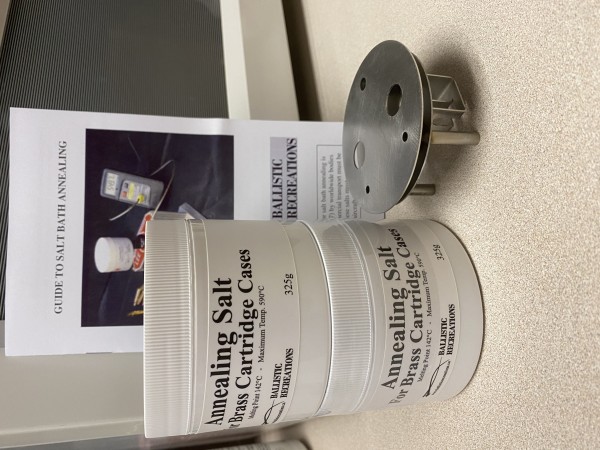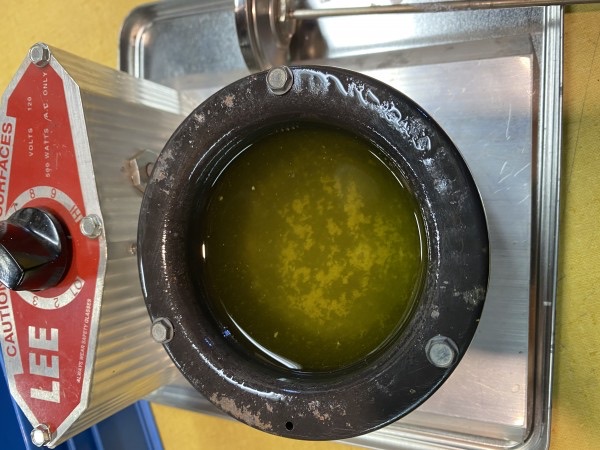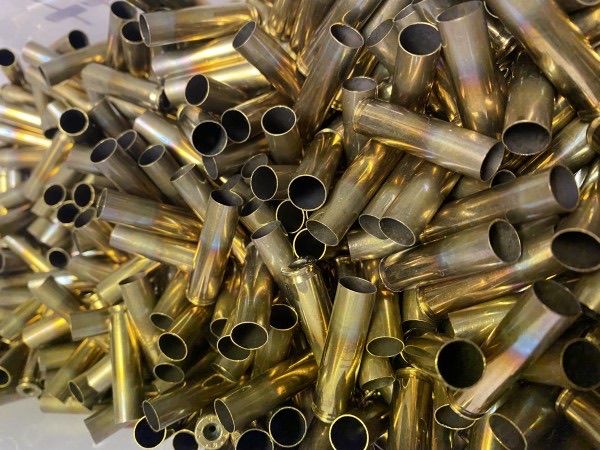The candle and lead methods both are things I first saw in metallurgist Fred Barker's article in Precision Shooting Magazine.
The graphite prevents the lead from soldering to the brass. The wet towel chills the case so the heat won't spread to the head, but that would only be a potential issue with short cases. I once trapped a thermocouple in the primer pocket of a 30-06 case with the end of a wood dowel, then heated the neck with the burner flame from my gas stove. I kept it in the fire a long time, rolling the dowel back and forth between my fingers, but air convection was removing heat below the shoulder fast enough that I never saw the head get warm enough to stress-relieve it in less than several hours.(1) Lead Pot Method: heat lead to 725°-750°F; dip neck into powdered graphite and then holding body of case in fingertips into molten lead: when case body becomes too hot to hold slap case into wet towel; or
(2) Candle-flame method: Hold case body in fingertips, place case neck in flame and twirl case back & forth until case body is too hot to hold, then slap case into wet towel; wipe soot off neck & shoulder with dry paper towel or 0000 steel wool.
Fred Barker, Precision Shooting Magazine (RIP), July 1996, pp. 90-92
It needs to be understood that annealing actually has three stages: recovery, recrystallization, and grain growth. The candle flame or lead pot methods generally only accomplish the first stage, getting atoms dislocated from the crystal lattices back in place. This is generally just fine to prevent neck splits in cases that are not being reformed. However, reforming may require further softening because it will work the brass harder, introducing new dislocations and grain boundary slipping in the process. If you have identified the need to further anneal brass, then the question becomes, how much time at what temperatures do you need to get to that softer state without starting grain growth (which reduced the strength of the brass)? There isn't one right answer. The reason is that the higher the existing stress in the brass, the lower the combination of time and temperature required to initiate recrystallization. A piece of 50% work-hardened brass can take nearly ten times longer to start recrystallizing at a given temperature than a 75% hard piece of brass does. Given neck splits occur on firing, for which the total linear stretch is small, and given that % elongation at break decreases with hardness, it is likely the brass in the neck is well over 90% work hardened when that happens, which means it would anneal quickly at a comparatively modest temperature, making it easy to oversoften. It also means that applying just enough time and heat to soften 90%+ work-hardened brass may do nothing to a piece of brass that has only been fired once and isn't yet very hard. This brings into question whether the various annealing machines that are supposed to anneal brass to the same degree each time you fire them can really do that if the brass doesn't all have an identical loading and firing history, and even if it does, it may do nothing to any of the brass until is has gone through enough load cycles to get fairly hard. In other words, brass annealed at every load cycle may simply go up through a series of hardening steps at each load cycle, getting harder and harder and then suddenly drop back to a softer state when it finally got hard enough for the annealing time and temperature combination to trigger recrystallization. It's really quite a messy business.
The saving grace for brass is it work-hardens quickly. Eric Cortina has a video in which he grossly overheats some brass until a bullet practically falls in but then shows one firing and resizing cycle gets it hard enough to seem to be working again. However, what I've always heard and that he did not test is that over-annealed brass will need to be annealed again sooner. Norma, for example, tests that their brass can be reloaded and fired at least ten times without splitting. It is part of their standard QC process to pull samples periodically during a run and test that it will tolerate that. I think we've all heard of 308 and other standard cases that have gone 20 reloads without starting to split. However, someone I knew who always annealed by bringing the brass to the start of a red glow (as seen in a darkened room) said he annealed every three to five reloadings to prevent splitting, which would indicate he was overdoing it. This may be due to grain growth. I don't know. Grain growth takes time to occur, and I don't know how fast it goes when you get the brass over 1000°F as the glowing stuff was.
This paper has a lot of information in it if the subject interests you.

|
   
   
|


|



 Reply With Quote
Reply With Quote
















